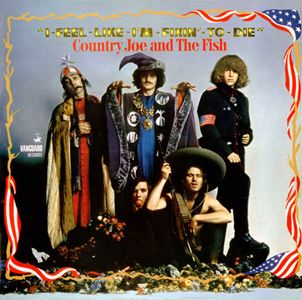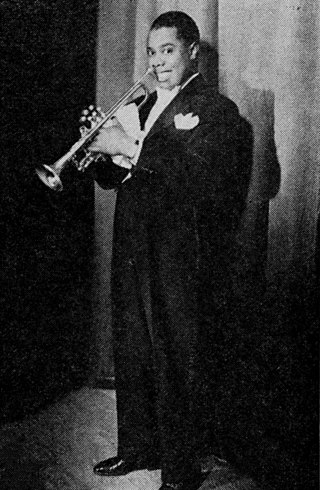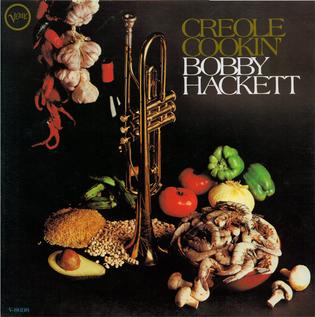Related Research Articles

Joseph Nathan "King" Oliver was an American jazz cornet player and bandleader. He was particularly recognized for his playing style and his pioneering use of mutes in jazz. Also a notable composer, he wrote many tunes still played today, including "Dippermouth Blues", "Sweet Like This", "Canal Street Blues", and "Doctor Jazz". He was the mentor and teacher of Louis Armstrong. His influence was such that Armstrong claimed, "if it had not been for Joe Oliver, Jazz would not be what it is today."

Edward "Kid" Ory was an American jazz composer, trombonist and bandleader. One of the early users of the glissando technique, he helped establish it as a central element of New Orleans jazz.

Albany Leon "Barney" Bigard was an American jazz clarinetist known for his 15-year tenure with Duke Ellington. He also played tenor saxophone.
Crescent Records was an American independent record label that produced jazz recordings from 1944 to 1946. It was founded by Nesuhi Ertegun to record a band that was assembled to perform on CBS Radio's 1944 variety series The Orson Welles Almanac. Only one group, Kid Ory's Creole Jazz Band, was released on the Crescent label, which was distributed by Hollywood's Jazz Man Record Shop. Although only eight discs were released, Crescent Records was involved in the international revival of traditional jazz in the 1940s.
The Hot Five was Louis Armstrong's first jazz recording band led under his own name.

"Tiger Rag" is a jazz standard that was recorded and copyrighted by the Original Dixieland Jass Band in 1917. It is one of the most recorded jazz compositions. In 2003, the 1918 recording of "Tiger Rag" was entered into the U.S. Library of Congress National Recording Registry.

Pure Dixieland is a mostly instrumental album of traditional New Orleans classics, from an ensemble of New Orleans jazz masters, including a young Harry Connick Jr at the age of eleven.
The New Orleans Wanderers was the name under which Lil Hardin recorded with members of Louis Armstrong's Hot Five on a 1926 session for Columbia. Armstrong himself was unable to appear since he was under contract to Okeh, although he collaborated with Hardin on three of the four songs. Four further songs were released by the same musicians under the name New Orleans Bootblacks. His place was taken by George Mitchell.

I-Feel-Like-I'm-Fixin'-to-Die is the second studio album by the influential San Francisco psychedelic rock band, Country Joe and the Fish, released in 1967. Recordings took place in Vanguard studios in 71 West 23rd Street, New York City. The title track remains one of the most popular Vietnam protest songs from the 1960s and originally appeared on a 1965 7-inch EP titled Rag Baby: Songs of Opposition. On the album, "I-Feel-Like-I'm-Fixin'-to-Die Rag" appears following "The Fish Cheer", which at concerts became a Country Joe standard. At Woodstock, Joe had the crowd yell F-U-C-K instead of F-I-S-H. Another musical highlight is the track "Janis" written for McDonald's then-girlfriend Janis Joplin. It is the second song written for a female musician for their albums, the other being "Grace". Two singles were released in the wake of the album. These include "Janis"/"Janis (instrumental)" and "Who Am I"/"Thursday".

A Night with Eddie Condon is a 2001 album by clarinetist Kenny Davern originally recorded live in 1971, joined of course by guitarist Eddie Condon. Performing swing and dixieland tunes that night, they are joined by Lou McGarity on trombone, among others.
The Red Hot Peppers were a recording jazz band led by Jelly Roll Morton from 1926–1930. They was a seven- or eight-piece band formed in Chicago which recorded for Victor and featured some of the best New Orleans-style freelance musicians available, including cornetist George Mitchell, trombonist Kid Ory, clarinetists Omer Simeon and Johnny Dodds, banjoists Johnny St. Cyr and Bud Scott, double bass player John Lindsay, and drummers Andrew Hilaire and Baby Dodds.

Albert Nicholas was an American jazz clarinet player.
Dixieland jazz, also referred to as traditional jazz, hot jazz, or simply Dixieland, is a style of jazz based on the music that developed in New Orleans at the start of the 20th century. The 1917 recordings by the Original Dixieland Jass Band, fostered awareness of this new style of music.

The period from the end of the First World War until the start of the Depression in 1929 is known as the "Jazz Age". Jazz had become popular music in America, although older generations considered the music immoral and threatening to cultural values. Dances such as the Charleston and the Black Bottom were very popular during the period, and jazz bands typically consisted of seven to twelve musicians. Important orchestras in New York were led by Fletcher Henderson, Paul Whiteman and Duke Ellington. Many New Orleans jazzmen had moved to Chicago during the late 1910s in search of employment; among others, the New Orleans Rhythm Kings, King Oliver's Creole Jazz Band and Jelly Roll Morton recorded in the city. However, Chicago's importance as a center of jazz music started to diminish toward the end of the 1920s in favor of New York.
"Ory's Creole Trombone" is a jazz composition by Kid Ory. Ory first recorded it in Los Angeles in 1921. The band included Ory on trombone, Mutt Carey on cornet, Dink Johnson on clarinet, Fred Washington on piano, Ed Garland on bass and Ben Borders on drums. The recording of "Ory's Creole Trombone" was released by John and Reb Spikes' short-lived Sunshine Records label. It was the first issued recording session by an African American jazz band from New Orleans. Other numbers recorded the same day included "When You're Alone Blues", "Krooked Blues", "Society Blues", "That Sweet Something Dear", "Maybe Some Day" and "Froggie Moore".

The Louis Armstrong Hot Five and Hot Seven Sessions were recorded between 1925 and 1928 by Louis Armstrong with his Hot Five and Hot Seven groups. According to the National Recording Registry, "Louis Armstrong was jazz's first great soloist and is among American music's most important and influential figures. These sessions, his solos in particular, set a standard musicians still strive to equal in their beauty and innovation." These recordings were added to the National Recording Registry in 2002, the first year of the institution's existence.

Hot Fives & Sevens is a 2000 box set collection of recordings made by American jazz trumpeter and singer Louis Armstrong with his Hot Five, Hot Seven, and other groups between 1925 and 1930. First released on JSP Records on 22 August 2000, the set was subsequently reissued on Definitive in 2001. A four-disc compilation, the set has received a "crown" as an author's pick in The Penguin Guide to Jazz and is also included in the book's "core collection" recommended for jazz fans. Allmusic concurs that it is "beyond indispensable", suggesting that "you can't have a Louis Armstrong collection without this historic set" or "any kind of respectable jazz collection" Alternatively, Ben Ratliff, writing in 2002, preferred Columbia's release The Complete Hot Five and Hot Seven Recordings.

The Smithsonian Collection of Classic Jazz is a six-LP box set released in 1973 by the Smithsonian Institution. Compiled by jazz critic, scholar, and historian Martin Williams, the album included tracks from over a dozen record labels spanning several decades and genres of American jazz, from ragtime and big band to post-bop and free jazz.

The Orson Welles Almanac is a 1944 CBS Radio series directed and hosted by Orson Welles. Broadcast live on the Columbia Pacific Network, the 30-minute variety program was heard Wednesdays at 9:30 p.m. ET January 26 – July 19, 1944. The series was sponsored by Mobilgas and Mobiloil. Many of the shows originated from U.S. military camps, where Welles and his repertory company and guests entertained the troops with a reduced version of The Mercury Wonder Show. The performances of the all-star jazz band that Welles brought together for the show were an important force in the revival of traditional New Orleans jazz in the 1940s.

Creole Cookin', is an album by cornetist Bobby Hackett which was released on the Verve label in 1967.
References
- Anderson, Gene Henry; Budds, Michael J. (2007). The Original Hot Five Recordings of Louis Armstrong. Pendragon Press. ISBN 978-1-57647-120-3.
- Bayles, Martha (1996). Hole in Our Soul: The Loss of Beauty and Meaning in American Popular Music. University of Chicago Press. ISBN 0-226-03959-5.
- Giddins, Gary (2004). Weather Bird: Jazz at the Dawn of Its Second Century . Oxford University Press US. ISBN 0-19-515607-2.
- Kernfeld, Barry Dean (1995). The Blackwell Guide to Recorded Jazz. Wiley-Blackwell. ISBN 0-631-19552-1.
- Scott, Derek B. (2003). From the Erotic to the Demonic: On Critical Musicology. Oxford University Press US. ISBN 0-19-515195-X.
- Wintz, Cary D.; Finkelman, Paul (2004). Encyclopedia of the Harlem Renaissance. Taylor & Francis. ISBN 1-57958-458-6.